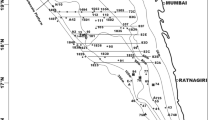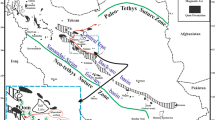Abstract
Halimeda bioherms, occurring primarily along the western and southern margins of Kalukalukuang Bank in the eastern Java Sea, display a wide variety of thicknesses and shapes. In general, high-frequency forms of the northern bank are replaced by thicker and lower frequency forms along the deeper southern margin. Sidescan sonar data suggest aperiodic reworking of shallow bioherm crests of the northern bank into features suggestive of bedforms. These features are not associated with deeper bioherms of the southern bank. Cores from the bioherms indicate that they consist mostly of disarticulated Halimeda plates set in a lime mud matrix composed largely of Halimeda fragments and foraminifera tests. Carbon-14 dating shows that, with exception of some deep southern bank examples, bioherms are actively accreting. Results of mineralogy and elemental chemistry on piston core PC-12 suggest cyclic variations in Mg-calcite (cement in Halimeda utricles), which may be related to periodic excursions of cold Pacific throughflow water onto the bank. Composition of the Mg-calcite (8.6 mole-%) suggests a temperature of formation of about 22 °C, which is 7 °C below average surface water temperatures. The carbon and oxygen isotope compositions of both aragonite and Mg-calcite phases are remarkably homogeneous, but were inconclusive with regard to the cold-water intrusion hypothesis. However, a lack of reef-building corals below a depth of ∼15 m, abundance of Halimeda bioherms on the western margin of K-Bank, where upwelling is predicted, extensive boring of sedimentary particles by endolithic boring algae, and high nutrient values of water at the thermocline (50–70 m deep) all support the incursion of cold, nutrient-rich water onto the bank. Upwelling and nutrient overloading are suggested as explanations for remarkable algal growth at the expense of reef-building corals.
Similar content being viewed by others
References
Alexandersson ET, Milliman JD (1981) Intragranular Mg-calcite cement in Halimeda plates from the Brazilian continental shelf. J Sediment Petrol 51:1309–1314
Burton EA, Walker LM (1987) Relative precipitation rates of aragonite and Mg-calcite from seawater: temperature or carbonate ion control? Geology 15:111–114
Davies PJ, Marshall JF (1985) Halimeda bioherms — low-energy reefs, northern Great Barrier Reef. Proc 5th Int Coral Reef Symp 5:1–7
Ebanks WJ Jr (1967) Recent carbonate sedimentation and diagenesis, Ambergris Cay, British Honduras. PhD thesis, Rice University
Goldsmith JR, Graf DL, Heard HC (1961) Lattice constants of the calcium-magnesium carbonates. Am Mineral 46:453–457
Grossman EK, Ku TL (1986) Oxygen and carbon isotope fractionation in biogenic aragonite: temperature effects. Chem Geol (Isotope Geoscience Section) 59:59–74
Hallock P, Schlager W (1986) Nutrient excess and the demise of coral reefs and carbonate platforms. Palaios 1:389–398
Hamilton W (1979) Tectonics of the Indonesia region. USGS Prof Paper 1078:345
Hine AC, Hallock P, Harris M, Mullins HT, Belknap DF, Jaap W (1988) Halimeda bioherms along an open seaway: Miskito Channel, Nicaraguan Rise, SW Caribbean Sea. Coral Reefs 6:173–178
Holmes CW (1983) δ18 variations in the Halimeda of Virgin Islands sands: Evidence of cool water in the northeast Caribbean, Late Holocene. J Sediment Petrol 53:0429–0438
Katili JA (1973) On fitting certain geological and geophysical features of the Indonesian island arc to the new global tectonics. In: Coleman PJ (ed) The eastern Pacific, Island Arcs, Marginal Seas. University of Western Australia Press, Nedlands
Murray SP, Arief D (in press) Net flow through the Lombok Strait, January 1985-January 1986. Nature
Orme GR (1985) The sedimentological importance of Halimeda in the development of back-reef lithofacies, northern Great Barrier Reef (Australia). Proc 5th Int Coral Reef Symp 5:31–37
Orme GR, Flood PG, Sargent GEG (1978) Sedimentation trends in the lee of the outer (ribbon) reefs, northern region of the Great Barrier Reef Province. Philos Trans R Soc London A291:85–99
Phipps CVG, Roberts HH (1988) Seismic characteristics and accretion history of Halimeda bioherms on Kalukalukuang Bank, eastern Java Sea (Indonesia). Coral Reefs 6:149–159
Phipps PJ, Davies RJ, Hopley D (1985) The morphology of Halimeda banks behind the Great Barrier Reef east of Cooktown, Qld. Proc 5th Int Coral Reef Symp 5:27–30
Ramage CS (1971) Monsoon meteorology. Academic Press, New York
Roberts HH, Murray SP, Suhayda JN (1975) Physical processes in a forming reef system. J Mar Res 33:233–260
Roberts HH, Phipps CV, Effendi L (1987a) Halimeda bioherms of the eastern Java Sea, Indonesia. Geology 15:371–374
Roberts HH, Phipps CV, Effendi L (1987b) Morphology of large Halimeda bioherms, eastern Java Sea (Indonesia): a side scan sonar study. Geo-Marine Lett 7:7–14
Samudra RV (1975) Hydrological, plankton, and pigment observations in the Makassar Strait, Madura Strait, and eastern Java Sea. Oceanographic Cruise Report 16. Institute of Marine Research, National Institute of Oceanology, Indonesian Institute of Science
Sukanto M (1969) The climate of Indonesia. World survey of climatology, vol 8: Climates of northern and eastern Asia. Elsevier, New York, pp 215–229
Tarutani T, Clayton RN, Mayeda TK (1969) The effects of polymorphism and magnesium substitution on oxygen isotope fractionation between calcium carbonate and water. Geochim Cosmochim Acta 33:987–996
Wyrtki K (1961) Physical oceanography of the southeast Asia waters. In: Scientific results of marine investigations of the South China Sea and the Gulf of Thailand (1969–1961). NAGA Rep 2:1–195
Author information
Authors and Affiliations
Rights and permissions
About this article
Cite this article
Roberts, H.H., Aharon, P. & Phipps, C.V. Morphology and sedimentology of Halimeda bioherms from the eastern Java Sea (Indonesia). Coral Reefs 6, 161–172 (1988). https://doi.org/10.1007/BF00302012
Accepted:
Issue Date:
DOI: https://doi.org/10.1007/BF00302012




